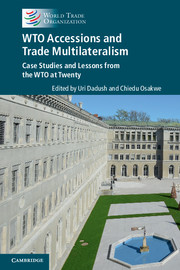Book contents
- Frontmatter
- Dedication
- Contents
- List of contributors
- Foreword
- Acknowledgements
- List of abbreviations
- Editors' note
- PART I WTO accessions, the trading system and the global economy
- 1 A reflection on accessions as the WTO turns twenty
- 2 Developments in the global economy and trading system effects: the transformation of world trade
- 3 The WTO and the global economy: contemporary challenges and possible responses
- 4 The structural reform implications of WTO accession
- 5 The macroeconomic implications of WTO accession
- 6 The future of Asia: unleashing the power of trade and governance
- 7 Eurasian Economic Union integration: timetable, priorities and challenges
- 8 WTO accessions: what does the academic literature say?
- PART II Overview: systemic outcomes from accessions
- PART III Members’ perspectives on accession negotiations
- PART IV Working party chairpersons’ perspectives on accession negotiations
- PART V Salient features inWTOAccession Protocols
- PART VI Conclusion
- Annex: Contributor biographies
- Index
- Plate section
- References
8 - WTO accessions: what does the academic literature say?
from PART I - WTO accessions, the trading system and the global economy
Published online by Cambridge University Press: 05 November 2015
- Frontmatter
- Dedication
- Contents
- List of contributors
- Foreword
- Acknowledgements
- List of abbreviations
- Editors' note
- PART I WTO accessions, the trading system and the global economy
- 1 A reflection on accessions as the WTO turns twenty
- 2 Developments in the global economy and trading system effects: the transformation of world trade
- 3 The WTO and the global economy: contemporary challenges and possible responses
- 4 The structural reform implications of WTO accession
- 5 The macroeconomic implications of WTO accession
- 6 The future of Asia: unleashing the power of trade and governance
- 7 Eurasian Economic Union integration: timetable, priorities and challenges
- 8 WTO accessions: what does the academic literature say?
- PART II Overview: systemic outcomes from accessions
- PART III Members’ perspectives on accession negotiations
- PART IV Working party chairpersons’ perspectives on accession negotiations
- PART V Salient features inWTOAccession Protocols
- PART VI Conclusion
- Annex: Contributor biographies
- Index
- Plate section
- References
Summary
ABSTRACT
This chapter takes stock of the recent academic literature on accessions. It focuses only on the analytical work published since 2000 in books, academic journals and working papers by key WTO scholars across the world. These contributions are related to the procedural, legal, economic and institutional aspects of WTO accessions, and to the proposals for their reform. Country-specific studies, research on the impact of accessions on individual industries and reports on accessions by national and international institutions are not included.
Revisiting the literature on WTO accessions accumulated since the start of the twenty-first century is a daunting exercise. The literature is vast and includes both in-depth theoretical analyses and empirical studies. It covers the legal, economic and institutional aspects of accessions, and includes numerous country- and sector-specific cases. A simple search for ‘WTO accessions 2000–2014’ in Google Scholar, which indexes scholarly literature, returns about 33,000 academic contributions across an array of publishing formats and disciplines.
Two relatively recent publications on accessions stand out clearly from this extensive list. First, A Handbook on Accession to the WTO (Williams, 2008), prepared by the WTO Secretariat, presents a broad overview of key aspects of accessions and provides the general reader with a basis for informed discussion and analysis of the WTO's membership process. It places accession in the context of the WTO, sets out the basic provisions governing accession and the standard procedures and terms of accession and brings together key documents used in the accession process. Second, the two-volume The WTO and Accession Countries (Primo Braga and Cattaneo, 2009), with contributions by some of the authors included in this review, explores the intertwined economic, legal and political dimensions of accessions. It also includes country cases and sector-specific issues in agriculture, services and intellectual property. Both publications remain valuable reference sources for scholars and practitioners grappling with the increasing complexity of WTO accession.
The academic literature broadly converges on the overall assessment of the accession process. The rationale of WTO accession includes better integration into the world economy by securing permanent and unconditional most-favoured-nation (MFN) status and protection against arbitrary protectionist measures by major trading partners. Negotiating costs are reduced by negotiating multilaterally rather than bilaterally or regionally, participating in international trade rule-making and accessing an impartial and binding dispute settlement mechanism.
- Type
- Chapter
- Information
- WTO Accessions and Trade MultilateralismCase Studies and Lessons from the WTO at Twenty, pp. 198 - 216Publisher: Cambridge University PressPrint publication year: 2015



